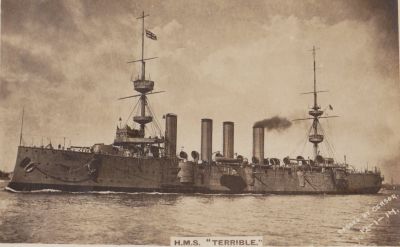
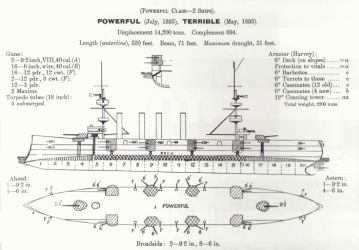
My maternal grandfather, Herbert Lee, served in the Royal Navy from 1898 to 1922. During this time he served aboard some quite interesting ships showing the development of naval ships from the sailing ships of the Victorian Navy to the aircraft carrier at the end of the First World War. As a Boy 1st class he joined HMS Terrible for passage to the China Station to join HMS Centurion.
HMS Terrible and Powerful were two cruisers built to counter a perceived threat from the Russian Navy, which was building two new cruisers at that time. The information was false and the Royal Navy was left with these very large ships, which at 14000 tons were bigger than many battleships of that era. The crew numbers required to work the enormous number of guns put a considerable strain on the manning of the fleet and the ships were never used to their full potential. They were used to transport large numbers of men while being used as a test bed for the Bellevillle boiler system.
Herbert Lee joined HMS Terrible for transport to the Far East to join HMS Centurion, a second class battleship, which at 10000 tons was considerably smaller. It just so happened that the Boer War broke out at that time and Terrible and Powerful both took part. Because of a lack of large guns, the British Army was badly outgunned by the Boers, so Captain Percy Scott of the Terrible had a number of ship's guns fitted with improvised mounts so that they could be used ashore. (Fifty Years in the Royal Navy by Captain Scott). He was made Commandant at Durban until after Ladysmith was relieved. After that the guns were re-embarked and the ship sailed for China.
On arrival off Taku Herbert Lee transferred to HMS Centurion, the flagship of Admiral Seymour with Captain John Jellicoe as Flag Captain. Centurion was a lightly armed battleship designed for service on foreign stations, with a draught shallow enough to allow passage through the Suez Canal. Her hull was sheathed with wood and copper so that she required less frequent docking.
Admiral Seymour led the first attempt to relieve Peking and Captain Jellicoe was badly wounded during the withdrawal so Herbert Lee joined the ship at quite an exciting time. He was rated Ordinary Seaman August 1900 having been involved in two wars before the age of 18.
After a year on HMS Centurion, at Taku, he was transferred to HMS Orlando, an armoured cruiser. She was the prototype modern cruiser when built in 1886, armoured, no sails, balanced armament and capable of 18 knots. While serving aboard her Herbert received the South African Ribbon, was rated Able Seaman and received £2 prize money from the South African War.
This photo of midshipmen on the quarterdeck of HMS Orlando c1900 seems to show a captured Chinese cannon. This may be the same one stolen by the Auroras on the night of the 19th December 1901 as mentioned in Herbert's notebook, page 17.
At the end of the commission Orlando returned to Portsmouth and was paid off. On 4th July Herbert received The South Africa Medal and the China Medal. As a youngster my mother called them Daddy's Queens.
Although Herbert was no longer aboard HMS Terrible on the 26th June 1902, Captain Percy Scott wrote "God save the King" on the ship's side using crew members to commemorate the coronation of King Edward VII. The fourteen letters took about two hundred and fifty men. (Fifty Years in the Royal Navy, page 169).
Herbert joined HMS Duke of Wellington, an ex sailing battleship launched as the Windsor Castle in 1852 on the day the Duke of Wellington died. She was renamed Duke of Wellington. She had an interesting life, having been cut in half and lengthened just before completion so as to have an engine fitted. When Herbert joined her she was a hulk roofed over to keep the weather out.
From HMS Duke of Wellington Herbert joined HMS Albacore, a composite screw gunboat, that is with an iron frame and wooden planking. She had been launched in 1883 and had taken part in the campaign against the Mahdists at Suakin in 1884. While aboard her Herbert had to learn how to proceed under sail. An interesting sidelight on the navy of those days is shown in Photo No 15, the bear being the ship's mascot. Herbert married in 1903 and one of the first jobs his wife had was mending his trousers after the bear had chewed them.
The next ship after that was HMS Powerful, sister ship to the Terrible already mentioned. His daughter Jane was conceived before he left but he did not see her until she was over two years old, after a commission out the Far East.
Herbert was one of the forward 9.2 inch gun crew.
Here is a signed copy of the ship, and a picture in dock at Cockatoo Island, Sydney. 18th May 1908 after Herbert had returned to England.
This picture is of HMS Pegasus, what was known as a protected cruiser. She was leaving Australia for England in November 1906 and as she passed between HMS Powerful and the shore she struck a rock and broke her port propeller. She docked and shipped a new one and sailed two days later. The other shows a steam pinnace returning libertymen to the fleet. Australia 1906.
Herbert left HMS Powerful on the 9th October 1907 and travelled home on the Transport Service, which was a sort of shuttle service using obsolete cruisers. As can be seen from the postcard the first part of the journey was aboard HMS Europa, a 1st class cruiser of 11000 tons and later on HMS Edgar, an older first class cruiser.
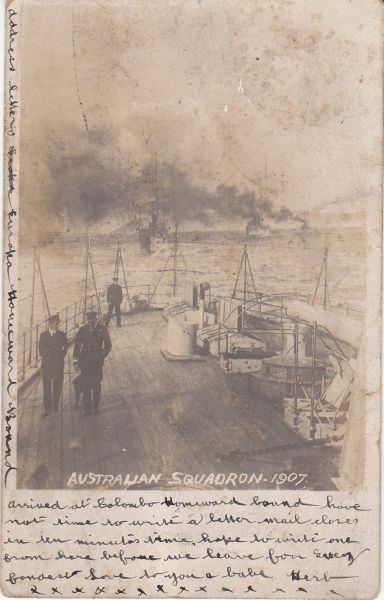
|
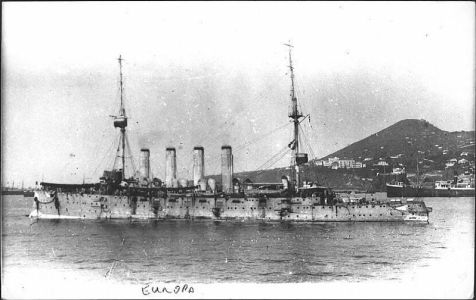
|
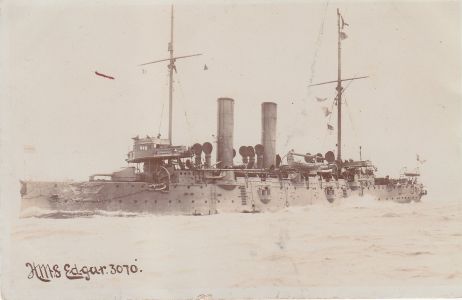
|
Herbert's next ship was HMS Hecla. This was built as a merchant ship, British Crown and purchased by the Royal Navy in 1878 and used in the development of torpedo boats. Later, from 1912 she was used as a destroyer depot ship and survived until 1926. He served aboard her from 16th April 1908 to 10th January 1912.
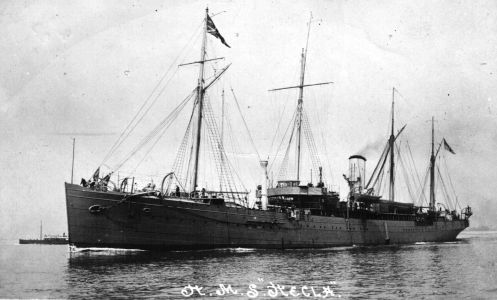
|
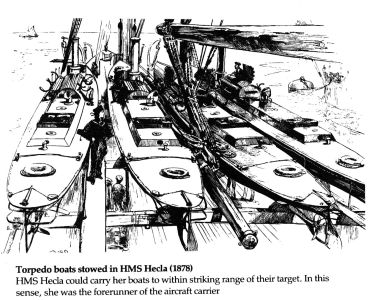
|

| |
From a local paper 24th June 1885
DISASTROUS COLLISION NEAR THE LANDS END. LOSS OF A STEAMER AND THIRTEEN LIVES.
The Hecla, torpedo depot ship, which has been attached to the Evolutionary Squadron, arrived in Plymouth Sound between 7 and 8 on Tuesday evening seriously damaged and requiring immediate attention from the Dockyard authorities. The Hecla, it seems, had been detached from Sir Geoffrey Hornby's squadron in order to convey a torpedo boat to Pembroke for repairs. There she waited and at 7 o'clock on Monday morning she started in company with the vessel she was supposed to accompany to Portland. On Monday night a heavy fog set in, and on Tuesday morning, when NNE of the Longships, the vessel collided with the steamer Cheerful, which was then on a voyage to Liverpool from Falmouth. The Hecla struck the Cheerful amidships, and it was at once seen that the nature of the injury was so serious that the vessel could not exist. The boats of the Hecla were launched within a minute and a half, and proceeded to the scene of the disaster, succeeding in rescuing 36 of her passengers and crew and bringing them to the man of war. The disabled ship sunk within four minutes, carrying down in her nine passengers and crew, while two of her complement the second mate and the wife of a surgeon - were picked up and conveyed on board the Hecla where, however it was found that they were so far gone as to preclude any possibility of recovery. The injuries to the Hecla were very serious. She had an immense hole in her prow, and by this means the fore compartment was literally filled, but owing to the immediate closing of her watertight doors the ship was kept afloat. The captain of the Hecla did all in his power to attend to the passengers and crew who were brought on board, and having placed collision mats and sails over the bow, steamed at a moderate speed for Plymouth.
Herbert's next ship was HMS Prince of Wales, a pre Dreadnought battleship. It was the first ship to be fitted with stockless anchors, which greatly simplified stowing the anchors. She collided with submarine C32 off the Isle of Wight on the 4th June 1913 and saw action in the Dardanelles 1915. Herbert served aboard from 14th May 1912 to 24th January 1914.
His next ship, from 23th June 1914 to 10th June 1916 was HMS Wolverine, a Beagle class destroyer, serving in the Mediterranean. The flotilla was based on, HMS Blenheim, an old cruiser converted to a depot ship for destroyers. At Cape Helles HMS Wolvereine tried to use her 4" gun as a howitzer, using half charges. Within 24 hours HMS Blenheim provided range tables for 4" half charges.
Wolverine was involved in a variety of actions from minesweeping and shore bombardment to action with Turkish destroyers. Herbert Lee was awarded Prize Bounty for an action in which the Turkish torpedo boats A2, A6, Otto Rudolph and Medjedieh Alardish were destroyed.
The next photograph shows Herbert Lee at his gun, the after 12 pounder
Here is an excerpt from the naval reports of the times.
Scorpion and Wolverine, destroyers, G-class, c,1,100t, 1-4in/3-12pdr/2-18in tt, 5th DF Mediterranean Fleet, two of nine temporarily-equipped minesweeping destroyers, sweeping some way inside the Straits to allow the battleships to reach bombardment positions, sweep wires passed and drawing apart. Turkish 4.1in shore batteries opened fire, Wolverine hit on bridge, Scorpion by shell in seaman's messdeck which started a fire, soon put out; Wolverine lost Cdr O Prentis her captain, a sub-lieutenant RNR and coxswain (on the 28th, probably night of 27th/28th). There were a few shrapnel holes in Scorpion (Lt-Cdr A B Cunningham - "ABC" of WW2 fame) soon repaired by destroyer depot ship Blenheim. Over the succeeding days, more destroyers were hit and damaged.
The ships supporting the left flank opened a heavy fire on the Turkish position. H.M.S. "Grafton" (Captain Henry E. Grace), H.M.S. "Raglan" (Captain Cecil D. S. Raikes), and H.M. Destroyer "Wolverine" (Lieutenant-Commander Adrian St. V. Keyes), were on duty in position to support the army, which they did most ably, undoubtedly inflicting heavy loss on the enemy. They were reinforced by H.M.S. "Russell", H.M.S. "Havelock", and H.M. Destroyer "Scorpion".
The skilful manner in which "Wolverine" (Commander O. J. Prentis) and "Scorpion" (Lieutenant-Commander A. B. Cunningham), ran close inshore after dark, and sent whalers ashore to bring off the remaining officers and men is highly commended.
On the 25th and 26th "Wolverine" (Commander O. J. Prentis) (killed in action - 28 April 1915, shore gunfire), "Scorpion" (Lieutenant-Commander (now Commander) A. B. Cunningham), "Renard" (Lieutenant-Commander L. G. B. A. Campbell), "Grampus" (Lieutenant-Commander R. Bacchus), "Pincher" (Lieutenant-Commander H. W. Wyld), and "Rattlesnake" (Lieutenant-Commander P. G. Wodehouse) carried out mine-sweeping operations under Captain Heneage inside the Dardanelles in a most satisfactory manner, being frequently under heavy fire. On the 26th the French sweepers "Henriette" (Lieutenant de Vaisseau Auverny), "Marius Chambon" (Lieutenant de Vaisseau Blanc), and "Camargue" (Lieutenant de Vaisseau Bergeon) assisted them, "Henriette" doing particularly well.
After sunset "Scorpion" and "Wolverine" ran in and landed parties, under fire, to search the beach from Kum Kale to the cliffs below fort No. 4. The former brought off two officers and five men, who had been unable to reach the boats.
Herbert's next ship was HMS Furious where he served as Able Seaman, 31 Mess from 26th June 1917 to 29th August 1919.
Furious was laid down by Armstrong 15th August 1916 as a 1st class cruiser of 19,100 tons, 750 x 88 ft, armed with two 18" guns and 11 5.5". Before completion the forward 18" gun was removed and a small flight deck built forward. She went to sea as a hybrid ship with one 18" gun and 10 5.5" in March 1918.
From 1919 to 1924 she was altered in stages to become a flush decked carrier with a complement of 33 aircraft and a small retractable bridge which was lowered when flying operations took place.
Furious saw war service at Narvik 1940, Norway 1940 and 1944, Malta convoys 1942, North Africa 1942 - 1943. She was broken up in 1948.